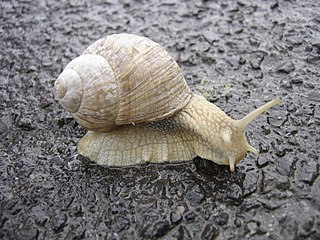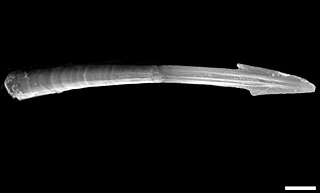
A snail is a shelled gastropod. The name is most often applied to land snails, terrestrial pulmonate gastropod molluscs. However, the common name snail is also used for most of the members of the molluscan class Gastropoda that have a coiled shell that is large enough for the animal to retract completely into. When the word "snail" is used in this most general sense, it includes not just land snails but also numerous species of sea snails and freshwater snails. Gastropods that naturally lack a shell, or have only an internal shell, are mostly called slugs, and land snails that have only a very small shell are often called semi-slugs.

Gastropods, commonly known as slugs and snails, belong to a large taxonomic class of invertebrates within the phylum Mollusca called Gastropoda.

Cornu aspersum, known by the common name garden snail, is a species of land snail in the family Helicidae, which includes some of the most familiar land snails. Of all terrestrial molluscs, this species may well be the most widely known. It was classified under the name Helix aspersa for over two centuries, but the prevailing classification now places it in the genus Cornu.

The operculum is a corneous or calcareous anatomical structure like a trapdoor that exists in many groups of sea snails and freshwater snails, and also in a few groups of land snails; the structure is found in some marine and freshwater gastropods, and in a minority of terrestrial gastropods, including the families Helicinidae, Cyclophoridae, Aciculidae, Maizaniidae, Pomatiidae, etc.

Terrestrial animals are animals that live predominantly or entirely on land, as compared with aquatic animals, which live predominantly or entirely in the water, and semiaquatic animals, which rely on both aquatic and terrestrial habitats. Some groups of insects are terrestrial, such as ants, butterflies, earwigs, cockroaches, grasshoppers and many others, while other groups are partially aquatic, such as mosquitoes and dragonflies, which pass their larval stages in water.

Sea snails are slow-moving marine gastropod molluscs, usually with visible external shells, such as whelk or abalone. They share the taxonomic class Gastropoda with slugs, which are distinguished from snails primarily by the absence of a visible shell.

The umbilicus of a shell is the axially aligned, hollow cone-shaped space within the whorls of a coiled mollusc shell. The term umbilicus is often used in descriptions of gastropod shells, i.e. it is a feature present on the ventral side of many snail shells, including some species of sea snails, land snails, and freshwater snails.

The gastropod shell is part of the body of a gastropod or snail, a kind of mollusc. The shell is an exoskeleton, which protects from predators, mechanical damage, and dehydration, but also serves for muscle attachment and calcium storage. Some gastropods appear shell-less (slugs) but may have a remnant within the mantle, or in some cases the shell is reduced such that the body cannot be retracted within it (semi-slug). Some snails also possess an operculum that seals the opening of the shell, known as the aperture, which provides further protection. The study of mollusc shells is known as conchology. The biological study of gastropods, and other molluscs in general, is malacology. Shell morphology terms vary by species group.

Sitala is a genus of air-breathing land snails, terrestrial pulmonate gastropod mollusks in the subfamily Durgellinae of the family Helicarionidae.
Liardetia boninensis is a species of small air-breathing land snails, terrestrial pulmonate gastropod mollusks in the family Euconulidae, the hive snails. This species is endemic to Japan.
Liardetia tenuisculpta is a species of small air-breathing land snails, terrestrial pulmonate gastropod mollusks in the family Euconulidae, the hive snails. This species is endemic to Micronesia.

A land snail is any of the numerous species of snail that live on land, as opposed to the sea snails and freshwater snails. Land snail is the common name for terrestrial gastropod mollusks that have shells. However, it is not always easy to say which species are terrestrial, because some are more or less amphibious between land and fresh water, and others are relatively amphibious between land and salt water.

Euconulidae is a taxonomic family of minute, air-breathing land snails, terrestrial pulmonate gastropod mollusks or micromollusks in the superfamily Trochomorphoidea.

A love dart is a sharp, calcareous or chitinous dart which some hermaphroditic land snails and slugs create. Love darts are both formed and stored internally in a dart sac. These darts are made in sexually mature animals only, and are used as part of the sequence of events during courtship, before actual mating takes place. Darts are quite large compared to the size of the animal: in the case of the semi-slug genus Parmarion, the length of a dart can be up to one fifth that of the semi-slug's foot.

Freshwater snails are gastropod mollusks that live in fresh water. There are many different families. They are found throughout the world in various habitats, ranging from ephemeral pools to the largest lakes, and from small seeps and springs to major rivers. The great majority of freshwater gastropods have a shell, with very few exceptions. Some groups of snails that live in freshwater respire using gills, whereas other groups need to reach the surface to breathe air. In addition, some are amphibious and have both gills and a lung. Most feed on algae, but many are detritivores and some are filter feeders.
George Alan Solem, known professionally as Alan Solem, was an American malacologist, a biologist who studied mollusks.

In the shell of gastropod mollusks, the lip is the free margin of the peristome or aperture of the gastropod shell.

Terrestrial molluscs or land molluscs (mollusks) are an ecological group that includes all molluscs that live on land in contrast to freshwater and marine molluscs. They probably first occurred in the Carboniferous, arising from freshwater ones.
Microcystidae is a family of land snails in the order Stylommatophora.














